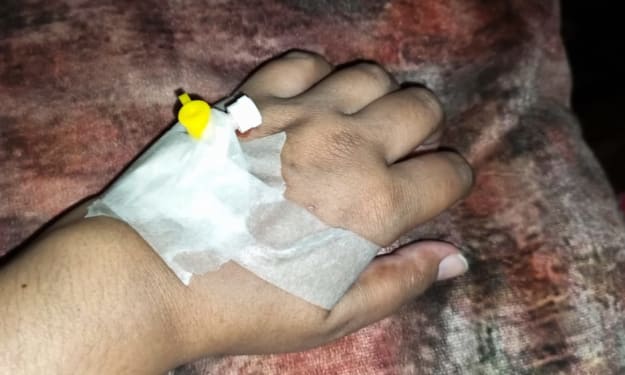A strange bone-eating worm
The worm that lives on the skeleton of a small gray whale in an underwater chasm off the coast of California is the first known whale bone-eating marine worm. On whale bones, once the female sea worm has burrowed in, it will never come out. The male worm does not have to carve anything because it lives inside the female worm. Bacteria in the 'roots' of female worms help them eat whale bone fat. A study of these two new worm species was published in the journal Science, published by the American Association for the Advancement of Science.

The worm is the latest discovery in a branch of biology that focuses on life arising from the remains of sunken whales. These fish carcasses sink to the bottom of the ocean and become mysterious and colorful oases, according to the author of the Science article, Robert Vrijenhoek, a researcher at the Monterey Bay Aquarium Research Institute at Moss Landing. Calif.
Bone-eating worms may play an important role in nutrient cycling. In terms of food volume, one dead whale is equivalent to thousands of years of "marine snow", life-sustaining carbon molecules that slowly fall to the ocean floor.

Worms have 'roots' and 'hairs'
The largest female tube worms that scientists have discovered are about the length of an index finger and about the size of a pencil. They have a tube on the outside, a long muscular body on the inside, an oviduct containing eggs, and lots of room for the males. A large egg sac eats into the bone, surrounded by a tissue filled with bacteria, which grows deep into the dead bone like tree roots.

These roots greatly help bacteria penetrate the bone from the front, or from the surface of the bone, according to study author Shana Goffredi of the Monterey Bay Aquatic Research Institute.
Bacteria in the roots help digest fat in the bones and transfer nutrients to the worm. How bacteria and worms communicate and transfer food to each other remains a mystery.
Above the worm there are red or red-white filamentous structures called "tentacles". Hemoglobin in the tentacles makes them red, absorbing oxygen for both the worm and its symbiotic bacteria.
This worm is distantly related to the large tube worms found in hydrothermal vents and cold water vents. Hydrothermal worms also rely on symbiotic bacteria to extract nutrients from their environment.
Discovering a species of golden worm
Scientists discovered the whale carcass while searching for mussels in the Monterey Bay. When the radar screen on a submersible lit up, Vrijenhoek thought they had crashed into a 55-gallon drum that someone had kicked off the ship. Instead of trash, their remote-controlled ship transmitted images of glowing red worms surrounding jawbones, skulls and bones. ribs of a small gray whale carcass. The fish's tissues, fins and many organs are still attached to the skeleton. Perhaps the whale carcass fell to the bottom of the ravine several months before scientists discovered it. The depth of the crevasse protected tissues and organs from predatory sharks and starving schools of hagfish.
When scientists on board controlled the ship's robotic arm to yank out a piece of whale bone, Vrijenhoek thought it was a previously known type of worm.
However, when he saw the mucus tubes clinging to the whale's bones, he knew he had discovered a golden worm. In 1995, Vrijenhoek and a team of scientists led by whale expert Craig Smith of the University of Hawaii found similar tubes but were not worms. With no worm carcasses to dissect and no DNA to analyze, they called the invisible creatures living in the tube "green slime worms."
Now he has the tube and the worm. Within a week of their discovery, scientists concluded that their DNA was unlike any DNA from other known worms. Further analysis assigned these worms to two new species, both of which belong to the bone-eating genus Osedax.
The smaller worm, Osedax frankpressi, has white and red hairs. The larger worm, Osedax rubiplumus, has completely red hairs.
Male worm dwarfs
Although scientists created a new breed of these worms, with a name that means "bone eaters", only female worms eat bones. Extremely small male worms, even adults, do not eat whale bones. Instead, these male worms feed on the egg yolk drops - the fatty remains of the eggs from which they develop.
Adult males appear largely unchanged from when they were larvae, apart from some hairs on the front and hooks on the back. In this species of worm, males and females are as different as two extremes. "If you saw a male worm, you would think it was a larva, but it can produce sperm," Vrijenhoek said.
This phenomenon of "sexual dimorphism" is especially surprising because males and females in closely related species of marine worms are often the same size, according to study author Greg Rouse of the South Australian Museum and University. Adelaide University in Adelaide, southern Australia.
Rouse discovered the microscopic males inside the females after colleagues sent him a piece of whale bone surrounded by red tassel worms.
Sperm cells from the male's packets compete to fertilize the eggs. They move toward the egg area on the female's hairy head. Inside the largest female that scientists studied were 111 males.
Among the many small worms stranded in the vast ocean, only a few land on a dead whale. Scientists hypothesize that worm larvae that find whale bones will develop into offspring. Larvae that land on females will develop into males. Worms that cannot find dead mammals or females usually die.
About the Creator
Ken aquariums
Telling stories my heart needs to tell <3 life is a journey, not a competition
If you like what you read, feel free to leave a tip,I would love some feedback
https://sites.google.com/view/hk-decor/trang-ch%E1%BB%A7
Enjoyed the story? Support the Creator.
Subscribe for free to receive all their stories in your feed. You could also pledge your support or give them a one-off tip, letting them know you appreciate their work.






Comments (2)
It's great, I hope there will be more articles to come
Very inspiring read, thanks for sharing.